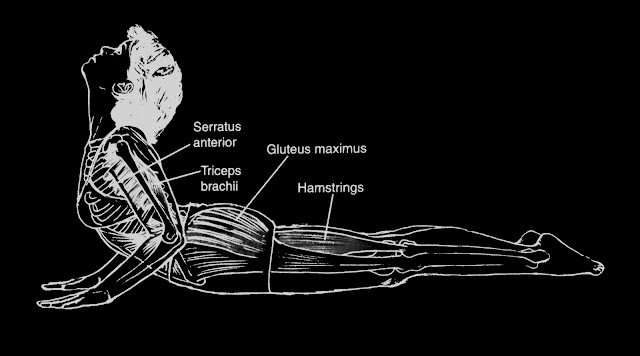Bhujangasana is one of the reconditioning asanas to stretch, bend, and twist the spinal cord in different ways, giving it a sort of massage which is intended to promote the health of the nerves rooted there. It is used in Chandra Namaskar or as an alternative to upward dog pose (Urdhva Mukha Svanasana) in Surya Namaskar.
What is bhujangasana?
Bhujangasana (in Sanskrit, भुजंगासन) derives its name from words bhujaṅga (in Sanskrit, भुजंग) and āsana (in Sanskrit, आसन). Bhujanga refers to “snake” (especially Cobra) and asana means “posture” or “seat”. The appearance of this asana resembles a Cobra snake with raised hood. It is also similar to Sarpasana meaning the serpent pose.
Mention in Scriptures

Translation in English
“Let the body, from the navel downwards to the toes, touch the ground, place the palms on the ground, raise the head (the upper portion of the body) like a serpent. This is called Bhujangâsana (Cobra posture). This always increases the bodily heat, destroys all diseases, and by the practise of this posture the serpent-goddess (the Kundalini force) awakes” [2].

Bhujangasana steps
- Lie on your stomach completely flat while keeping legs straight.
- Bring your feet together, heels touching slightly to each other and toes pointing outwards.
- Place the palm of your hands by the side of your chest, your arms must be close to your body with elbows pointing outward.
- The elbows must be hugged to the sides of your body.
- Rest your forehead on the floor and relax your body.
- Inhale breath and gently raise your forehead, neck and eventually your shoulders.
- Using your back muscles raise your chest.
- Now, use the strength of your arms to raise your trunk.
- Look upward breathing normally. This is the desired position like a serpent.
- Some texts suggest to gaze downwards on the mat or floor.
- In the final position, your navel should not raise more than 3 cm. While your pubic bones anchored to the floor.
- Hold this position for as long as it is comfortable. A beginner is advised to hold for 20 – 30 seconds.
- Now come back to initial position. Release breath and gently lower your navel, chest, neck, shoulders, and forehead.
- Take deeper breaths and relax while lying down.
- Practice for five rounds.
Variations of Bhujangasana yoga
- Bhujangasana (common)
- Dwi Hasta
- Eka Hasta
- Poorna
- Shashank
- Tiryaka
Bhujangasana benefits (labh)
- It can stimulate Manipura chakra. Thus distributing the generated energy of kundalini all over the body.
- Cobra pose keeps the spine supple. Also tones the spinal nerves.
- It improves circulation in the back region.
- This asana tones the ovaries and uterus, and helps alleviate menstrual and other gynaecological disorders.
- It stimulates digestion and relieves constipation.
- It improves the functioning of the liver and massages the kidneys and adrenal glands.
- The secretion of cortisone is maintained and the thyroid gland is regulated.
Bhujangasana contraindications
- Sphinx asana and Sarp asana are good preparatory pose for this asana.
- People with serious eye, heart or back conditions, high blood pressure and those in the early post-operative or post-delivery period should not attempt this asana.
- People suffering from peptic ulcer, hernia, intestinal tuberculosis or hyperthyroidism should not practise this asana without expert guidance.
Learn about more Yoga Techniques through our Yoga Guide Section.
References
- Book: Hatha Yoga – The report of a personal experience, by Theos Bernard
- Book: Gheranda Samhita – A treatise on Hatha Yoga, translated by Sris Chandra Vasu
- Book: Asana Pranayama Mudra Bandha by Swami Satyananda Saraswati
- Wikipedia: Bhujangasana [link]
